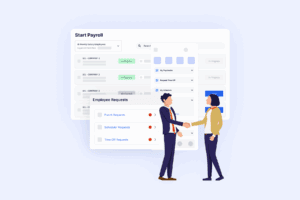Share
Organizations need to be able to adapt. It’s easy to buy new software and rewrite policies, but it’s harder to get workers to change their behavior. Change management keeps everyone engaged and on track.
What is change management?
Everyone needs to reach the desired endpoint, not just your most cooperative employees. You can break change management into three steps:
- Define the change
What is your goal for the future state of your organization? How will employees need to participate for the change to be successful? What’s your deadline?
- Plan for change
Don’t rush to implement. Take the time to get employee insights and input. Be transparent to avoid blindsiding workers. Divide big transitions into smaller steps.
- Support the change
Share and follow a roll-out plan with personalized training. Get feedback and make adjustments along the way. Keep upper management invested and involved.
Why is change management important?
We all know stories about failed attempts at change. Employees might see a new procedure as annoying or misguided. Individuals and teams may choose to keep doing things “the old way”. More than causing division and dysfunction, a failed transition can totally break down trust and productivity. Change management helps your business transition smoothly.
Applying change management strategies in your HR technology rollout
Whatever your industry, HR technology can streamline the way you manage workers. It’s reasonable that workers may worry about changes to important software like payroll and scheduling. Use change management to reduce resistance and increase adoption for new HR programs.
Create a detailed roll-out plan
You know that a big roll-out can’t happen overnight. Take the time to plan each step and its implications. Thoughtful planning can prevent future headaches.
- Consider existing HR processes: How do employees interact with the current system? Have the capabilities (and limitations) of current systems shaped policies that need updating?
- Establish clear objectives: What are your goals and priorities with the new HR technology? Are you aiming for specific improvements? Decide how to measure adoption rates.
- Assess risks: List the potential consequences of a failed transition. Make sure your new HR software is cyber ready.
- Leadership buy-in: Cultivate a strong relationship between the C-suite and HR. You need more than lukewarm support to follow through.
- Identify primary users: Which employees will interact with the new technology? Make sure they’re on board with the change.
READ: HR Technology Implementation Tips to Ensure Company-Wide Adoption
Communicate early and often
Transparency is more than a buzzword. Vague and foreboding announcements fuel anxiety, but you should try to give advance notice about big transitions. Explain why a change is necessary when you have a good idea of the path forward.
- Aligned communication: Make sure that managers and other stakeholders are on the same page. Confusion and contradictions will add grist for the rumor mill.
- Emphasis on benefits: Change can be frightening, so be sure to highlight the positives. How will benefits like improved efficiency benefit workers? Nobody likes learning to navigate a new portal, but everyone appreciates accurate paychecks.
READ: Top Ten Tips for Improving HR Communication
Provide contextual and personalized training
Some workers will need specialized training, like managers who make schedules and approve leave. Try not to burden workers with information they won’t be able to use. Tailor the material to the workflow and circumstances of your company.
Implement change in phases
Don’t expect a total and immediate transformation. Depending on the software, you might be able to start with a small test group. Can you transition one department at a time? Spread a bigger change over multiple days or weeks.
Address employee resistance to change
Create a culture of feedback where employees feel valued. Answer questions one-on-one or in group meetings as appropriate. Workers usually have valid concerns. People who feel ignored may become more stubbornly resistant.
Track user progress and course-correct
HR software can help follow individual performance and adoption. Have managers check in with anyone who seems to be struggling. You might be missing an important piece or bottleneck. Don’t be afraid to adjust your schedule and strategy for change.
Never lose sight of the “why”
Your goal isn’t “breaking the resistance”–even if it’s always the same workers causing trouble. Remember how the new tech is supposed to benefit the company. Depending on the roadblocks encountered, your plan for “change management” should also be open to change.
Live the change
Persistence goes a long way. You can set the example by staying positive and committing to the planned transition. Listen to feedback and concerns, but don’t turn every complaint into a crisis. Continue to improve the new system even after the formal change has been completed.
Discover how Netchex can help your organization effectively adopt new HR technology with proven change management strategies:
Related articles

All-in-One vs. Piecemeal HR Tools: What the Data Says

Solving Auto Dealership HR & Payroll Pain Points: The Best Practices Guide 2025-2026

Human Resources Technology

